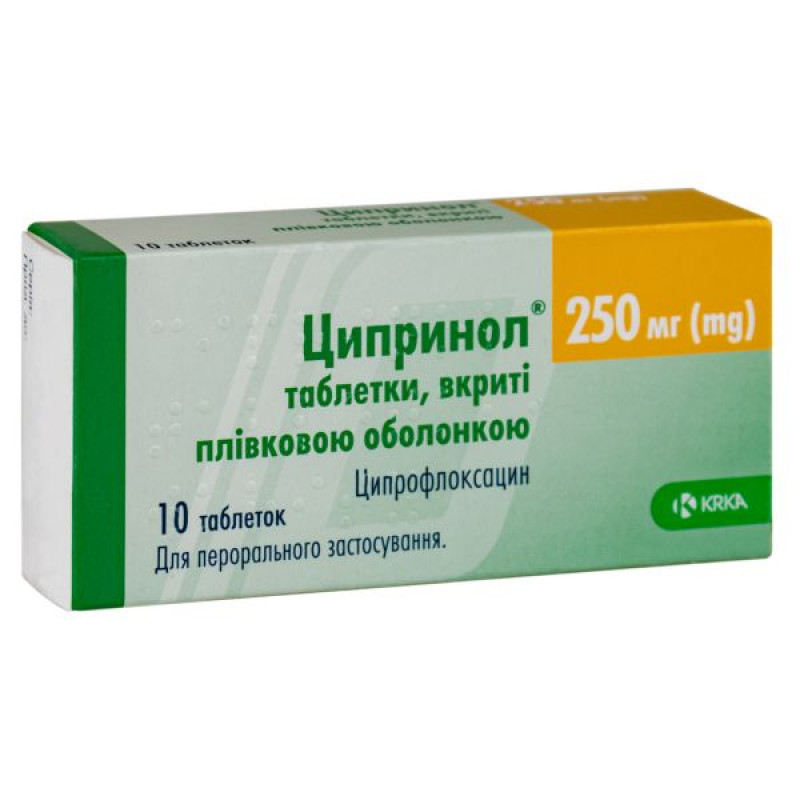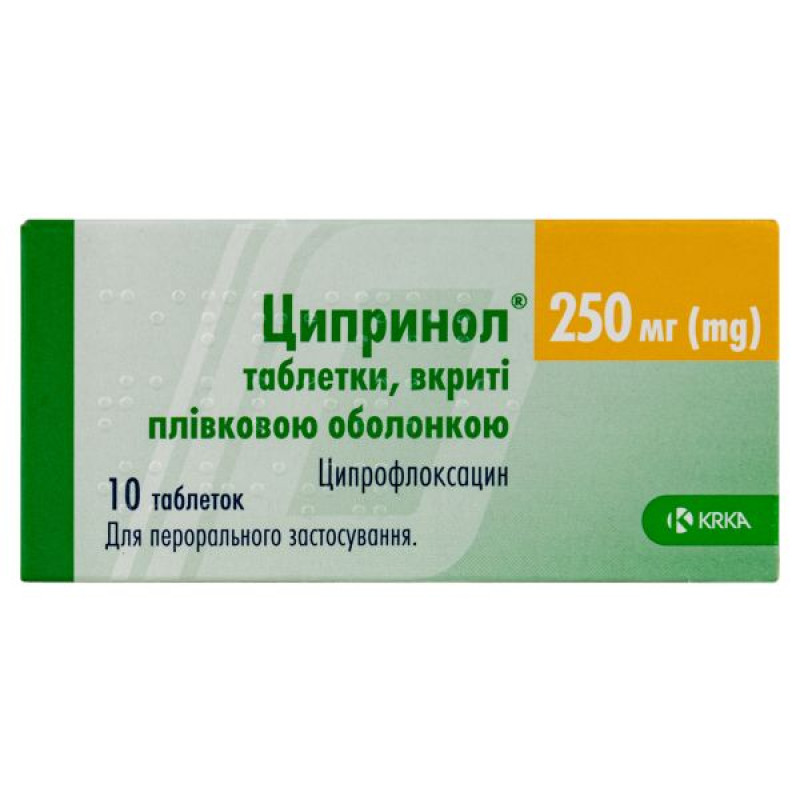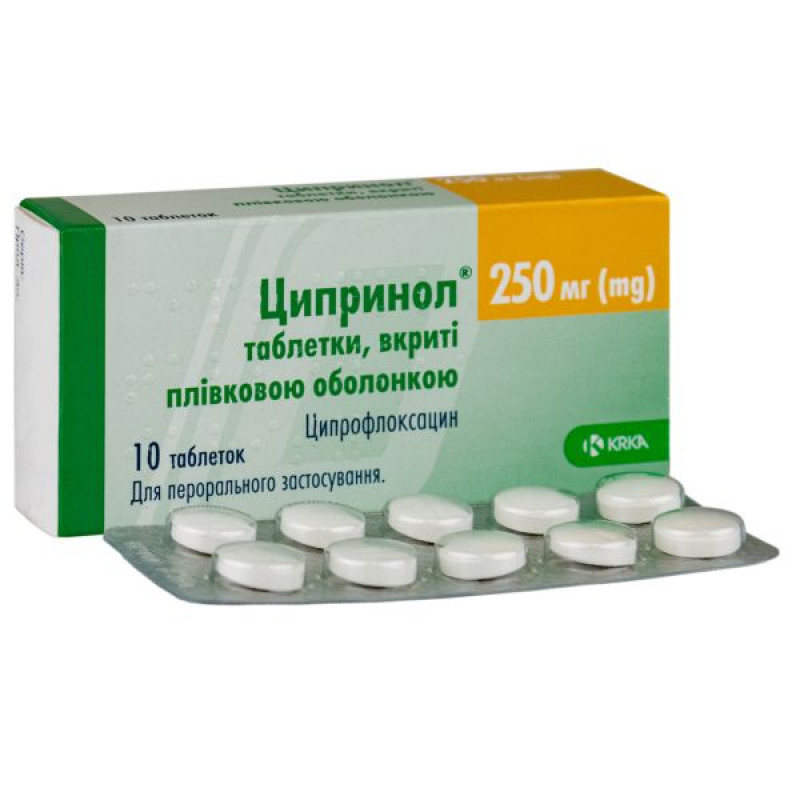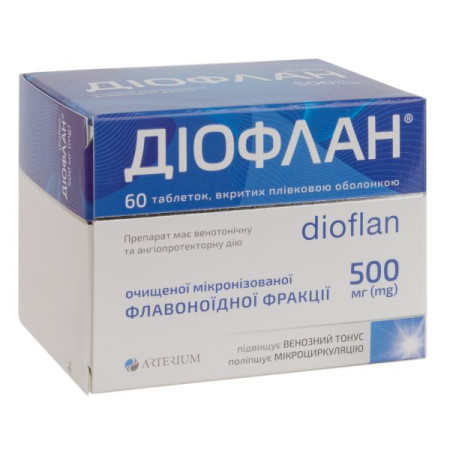Tsiprinol film-coated tablets 250 mg No. 10

Pharmacological properties
Pharmacodynamics. Mechanism of action. Ciprofloxacin in vitro exhibits high efficacy against a wide range of gram-negative and gram-positive pathogens. The mechanism of antibacterial action is due to the ability of ciprofloxacin to inhibit type II topoisomerases (DNA gyrase and topoisomerase IV), which are necessary in many processes of the DNA life cycle, such as replication, transcription, repair and recombination.
Efficacy mainly depends on the ratio between the maximum serum concentration (C max) and the minimum inhibitory concentration (MIC) of ciprofloxacin for the bacterial pathogen, and on the value of AUC and MIC.
The following genera and species of bacteria are generally susceptible to ciprofloxacin in vitro (for the Streptococcus species, see Special Precautions for Use).
| Sensitive (usually) types of microorganisms |
| Gram-positive aerobic microorganisms Bacillus anthracis 1) |
| Gram-negative aerobic microorganisms Aeromonas spp. Brucella spp. Citrobacter koseri Francisella tularensis Haemophilus ducreyi Haemophilus influenzae 2) Legionella spp. Moraxella catarrhalis 2) Neisseria meningitidis Pasteurella spp. Salmonella spp. 2) Shigella spp. 2) Vibrio spp. Yersinia pestis |
| anaerobic microorganisms Mobiluncus |
| other microorganisms Chlamydia trachomatis 3) Chlamydia pneumoniae 3) Mycoplasma hominis 3) Mycoplasma pneumoniae 3) |
| Species for which acquired resistance may develop |
| Aerobic Gram-positive microorganisms Enterococcus faecalis 3) Staphylococcus spp. 1) 4) |
| Aerobic Gram-negative microorganisms Acinetobacter baumannii 5) Burkholderia cepacia 2) 5) Campylobacter spp. 2) 5) Citrobacter freundii 2) Enterobacter aerogenes Enterobacter cloacae 2) Escherichia coli 2) Klebsiella oxytoca Klebsiella pneumoniae 2) Morganella morganii 2) Neisseria gonorrhoeae 2) Proteus mirabilis 2) Proteus vulgaris 2) Providencia spp. Pseudomonas aeruginosa 2) Pseudomonas fluorescens Serratia marcescens 2) |
| anaerobic microorganisms Peptostreptococcus spp. Propionibacterium acnes |
| Microorganisms initially resistant to ciprofloxacin |
| Aerobic Gram-positive microorganisms Actinomyces Enterococcus faecium Listeria monocytogenes |
| Aerobic Gram-negative microorganisms Stenotrophomonas maltophilia |
| anaerobic microorganisms Except for the above |
| other microorganisms Mycoplasma genitalium Ureaplasma urealyticum |
| 1) It has been shown that taking antibiotics immediately after exposure to Bacillus anthracis spores helps prevent disease if the number of spores can be reduced below the infective dose. A 2-month course of oral ciprofloxacin 500 mg twice daily is considered effective in preventing anthrax infection in adults. The physician should refer to national and/or international protocols for the treatment of anthrax. 2) Clinical efficacy has been demonstrated for susceptible isolates in approved clinical indications. 3) Natural average sensitivity in the absence of an acquired resistance mechanism. 4) Methicillin-resistant S. aureus is very often also resistant to fluoroquinolones. The rate of methicillin resistance of all staphylococcal species is about 20-50% and is usually high in hospital isolates. 5) Resistance rate ≥50% in one or more EU countries. |
Studies of single-dose toxicity, repeated-dose toxicity, carcinogenic potential, or reproductive toxicity of ciprofloxacin revealed no special hazard for humans.
Pharmacokinetics. Oral administration
Absorption: Ciprofloxacin is rapidly and well absorbed after oral administration, mainly from the upper small intestine.
C max in blood plasma is reached after 1-2 hours.
Single doses of 100-750 mg lead to dose-dependent C max between 0.56 and 3.7 mg/l. Serum concentration increases proportionally with increasing dose up to 1000 mg.
The bioavailability of the drug is 70-80%.
Distribution. The proportion of ciprofloxacin binding to blood proteins is insignificant (20-30%), it is found in blood plasma mainly in a non-ionized form. Ciprofloxacin freely diffuses into the extravascular space. The significant volume of distribution at steady state, which is 2-3 l/kg of body weight, proves that ciprofloxacin penetrates into tissues in concentrations that can many times exceed the level of the drug in blood serum. Ciprofloxacin reaches high concentrations in various tissues, for example in the lungs (epithelial fluid, alveolar macrophages, biopsy samples), sinuses, burn damaged tissues and tissues of the urinary tract, genital organs (prostate gland, endometrium), where the total concentration exceeds that in blood plasma.
Metabolism: Small concentrations of the following 4 metabolites have been detected: diethylciprofloxacin (M1), sulfociprofloxacin (M2), oxociprofloxacin (M3) and formylciprofloxacin (M4). The metabolites exhibit in vitro antimicrobial activity, but less than that of the parent compound. Ciprofloxacin is known to be a moderate inhibitor of CYP450 1A2 isoenzymes.
Excretion. Ciprofloxacin is excreted mainly unchanged both by the kidneys and through the intestines. T ½ in blood in individuals with normal renal function is approximately 4-7 hours.
| Ciprofloxacin elimination (% dose) after oral administration |
| ciprofloxacin | 44.7 | 25.0 |
| Metabolites (M1-M4) | 11.3 | 7.5 |









